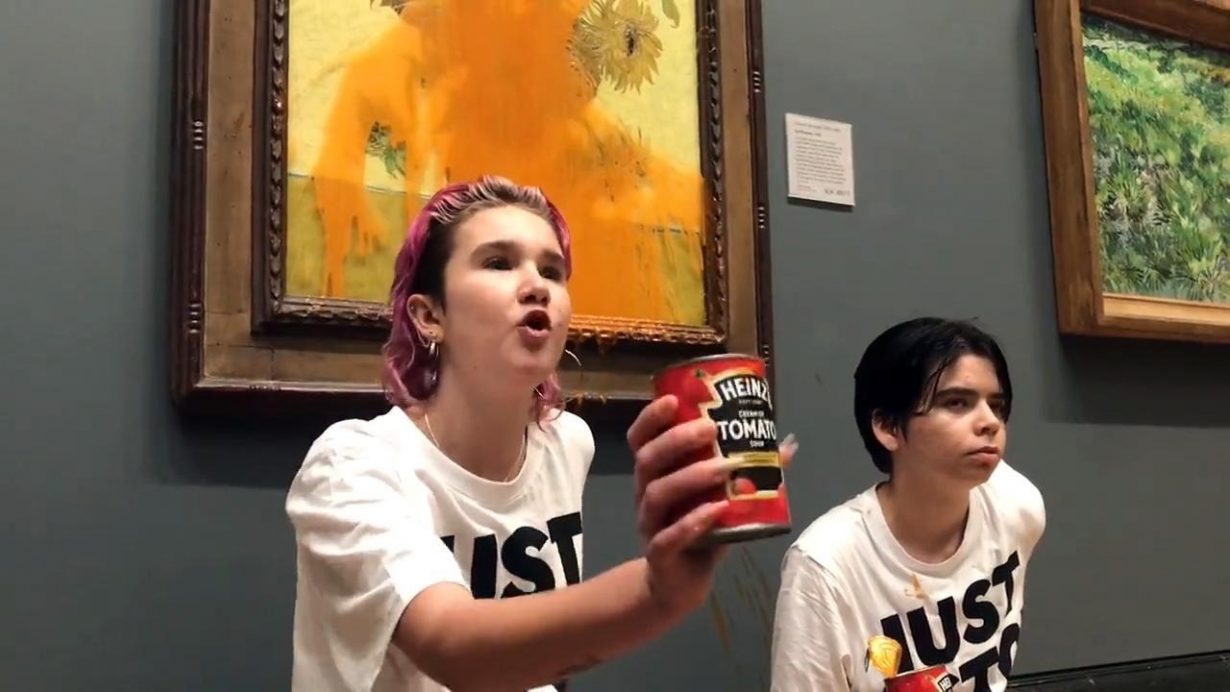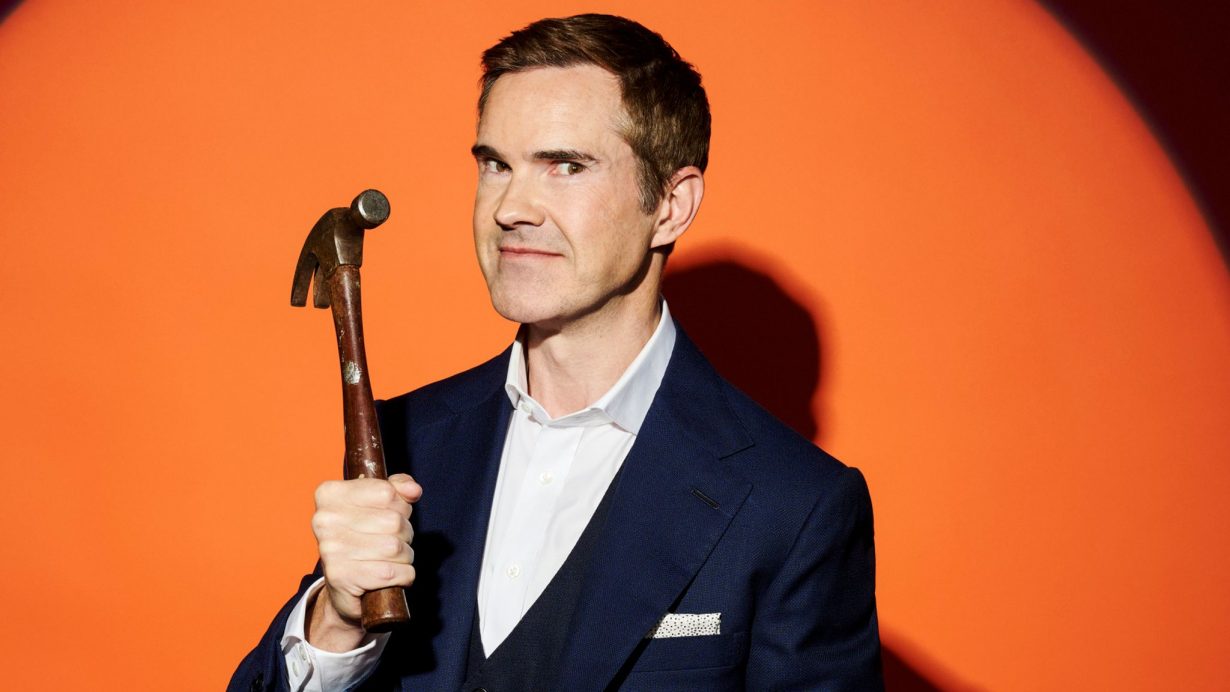Art is implicated in the climate disaster whether it wants to be or not

The destruction of art has been in the news quite a bit recently. Most obviously, last Friday two activists from the group Just Stop Oil staged a protest at the National Gallery in London, where they threw tomato soup over Vincent van Gogh’s Sunflowers (1888) before gluing themselves to the wall. The painting wasn’t actually damaged (it was under glass in the frame, so was quickly wiped down and put back on display hours later), but certainly the outrage the action triggered often spoke as if the protesters had destroyed the art – leading some to wonder whether the protest was any sort of good idea, or if it could even be justified at all.
Over on the much more stupid side of the news: the day before Van Gogh’s Sunflowers got souped, it was announced that Channel 4 had bought a painting by Adolf Hitler, so that it could star in a TV show where comedian Jimmy Carr may or may not destroy a piece of art by a ‘problematic’ person after a debate. Other artists to be featured on Jimmy Carr Destroys Art include Pablo Picasso, and Eric Gill (although I wonder if the producers might also get ‘meta’ with it and have their host possibly destroy all known copies of a comedy special by Jimmy Carr – who, among other things, has in the past avoided paying tax, and joked about how Roma and Sinti people deserved to die in the Holocaust). And a few days before, Damien Hirst had ceremonially burned 1000 of his spot paintings in London, as part of a work in which collectors must choose between owning a physical painting, and an NFT of it – if the latter, the former had to be destroyed.
So when, if ever, is it OK to deliberately destroy art? Obviously, some art is ‘about’ its own destruction, as Hirst’s was, so that seems fine (even if Hirst’s statement, as ever, plays with the intrusion of capital into the artworld in a way that can seem crass as a result of how personally enriched he always is by what he does). A better recent example would be Precious Okoyomon’s striking To See the Earth Before the End of the World (2022), displayed at this year’s Venice Biennale. Over the course of the exhibition, invasive kudzu weeds Okoyomon has planted around her sculptures grow uncontrollably, choking the rest of the art out. Another more obvious (and much less beautiful) statement to this effect was given by Banksy’s self-destructing Love is in the Bin (2018), a painting of his famous Girl with Balloon image which was fitted with a shredder in the frame, and destroyed itself as soon as it was auctioned.

Of course, one might still object to the immense destruction of value this might represent. Banksy’s work, for instance, had just been auctioned for $1.4 million (although in this case the destruction, and subsequent media attention, massively increased the work’s value: it was sold three years later for $25 million).
Such questions were raised perhaps most famously by the KLF’s notorious The K Foundation Burn a Million Quid (1994), in which Bill Drummond and Jimmy Cauty took the bulk of their earnings as a chart pop duo and filmed themselves destroying the banknotes at a remote spot on the Scottish island of Jura. If the money was art, then it seems fine to destroy it, since the destruction was the art. But if the money was money, then surely it could have been better spent on something else (Hirst’s NFTs remain ‘money’ in this sense, even if most NFTs, right now, are struggling to retain their value).

Sometimes the destruction of art is required for legal reasons – as with Rachel Whiteread’s wonderful, haunting House (1993), a concrete cast of the inside of a condemned building, which was created on the understanding that it would itself soon have to be destroyed, so the council could press on with redevelopment work. Architecture is often destroyed for similar reasons: from the original Pennsylvania Station in New York, to iconic brutalist landmarks like the Get Carter car park in Gateshead.
These acts of destruction are often, of course, a mistake – and can trigger a great deal of outrage. But we tend to be more accepting of them, than we would if someone destroyed Sunflowers (for example). Architecture has functions other than aesthetic ones; Whiteread’s House was taking up space required for, you know, actual houses. Certainly in the case of House, the inevitable destruction of the sculpture might arguably have enhanced its beauty: if it was permanent, that would have been the wrong thing to do. But to see it in photographs, and know that it was temporary, means that we could only ever see it as a ghost.
Jimmy Carr Destroys Art invites us to entertain the thought that sometimes it might be OK to destroy art because of certain facts about its creator. Here of course the question turns not only on the awfulness of the artist, but also the greatness of the art. Artists like Picasso might have mistreated those around them, but that hardly means it would be OK to have Jimmy Carr smash Guernica (1937) up on live TV (then again, I suppose arguing this point is precisely the point of the show). Destroying a painting by Hitler, by contrast, seems like it would probably be fun – not just because it was by a genuine monster, but because there is absolutely nothing remarkable about his work. That said, there wouldn’t really be that much point to it beyond that. The more borderline case is Eric Gill, who sexually abused his daughters – which has led groups to demand his work be removed from, for instance, church buildings.

But removing works from display in certain contexts isn’t the same as having Jimmy Carr destroy them with a big hammer. Maybe Jimmy Carr should be prevented from destroying works by Eric Gill in all cases; but then, would Gill’s victims have been justified in doing it? Maybe it’s OK to destroy ‘problematic’ art as part of an explicit protest against it – but one trivializes the issue in unforgivable ways if one does so in the context of a panel show on Channel 4?
With the Sunflowers stunt (and bearing in mind that nothing was actually destroyed, the protesters were just being a bit reckless), a whole plethora of issues have been raised. These include questions of strategy (was the stunt wise? If you want to ‘Stop Oil’, was this something that we might say was tactically sound? How does the Sunflowers action compare to the group’s subsequent protest blocking the Dartford Crossing? Did it help win much-needed attention, or did it turn public sentiment unnecessarily hostile?), as well as of appropriateness of target (yes, the artworld has big money floating around it, but what culpability does Van Gogh have for the fossil fuel industry here?). Suppose the work had been irreparably damaged – wouldn’t this have triggered a backlash, that would have hindered the group in its aims? (Or else might it, conversely, have reminded everyone that this is really what’s at stake here, should climate change be allowed to continue unabated?).

If the question is, ‘If you could stop climate change by destroying Sunflowers, would you do it?’, I’m sure most people would answer, ‘yes’. One painting is nothing compared to the end of the world: if nothing else, the end of the world would also mean the end of art, whose ‘inherent’ value will only last as long as value as such does. If the world really does gradually, from here, slope unstoppably towards Armageddon, all aesthetic objects will rapidly cease to mean anything at all. If this is right, then destroying art could well be justified, as a mean towards securing some particular, world-savingly positive effect.
Obviously this can’t justify the Sunflowers action in itself, as the causality simply isn’t clear: chucking soup at Sunflowers might help, but let’s face it, it probably won’t. Frankly though I think that probably chucking soup at a painting as a protest is fine, as it has led to the group getting a lot more attention, and no harm was really done overall.
Perhaps in truth what we ought to say about all this is that now, with the global situation being as serious as it is, art is implicated in the climate disaster whether it wants to be or not; whether this would be an anachronistic way of ‘appreciating’ a work like Sunflowers or otherwise. Some people, sure, want to cordon the loveliness of a painting of some flowers off from a world which threatens the possibility of there being no such flowers any longer. But I think it should be obvious that this is barbaric. Artists, collectors, curators, all have specific duties to the environment, just by virtue of being human beings. Maybe they have duties to some ideal of ‘art’ too. But the former can’t possibly be trumped by the latter.